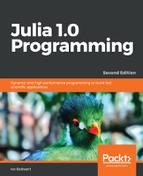Everything in Julia is an expression that returns a value when executed. Every piece of the program code is internally represented as an ordinary Julia data structure, also called an expression. In this chapter, we will see how, by working on expressions, a Julia program can transform and even generate new code. This is a very powerful characteristic, also called homoiconicity. It inherits this property from Lisp, where code and data are just lists, and where it is commonly referred to with the phrase: Code is data and data is code
.
In homoiconic languages, code can be expressed in terms of the language syntax. This is the case for the Lisp-like family of languages: Lisp, Scheme and, more recently, Clojure, which use s-expressions. Julia is homoiconic, as are others such as Prolog, IO, Rebol, and Red. As such, these are able to generate code during runtime, which can be subsequently executed.
We will explore this metaprogramming power by covering the following topics:
- Expressions and symbols
- Evaluation and interpolation
- Defining macros
- Built-in macros
- Reflection capabilities
